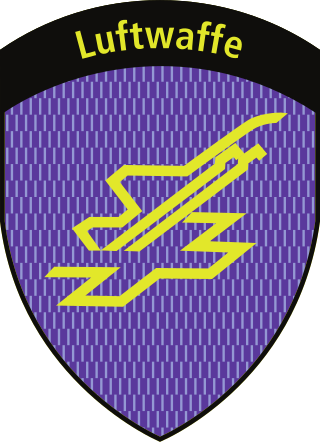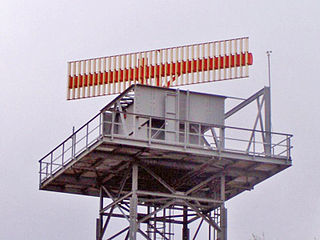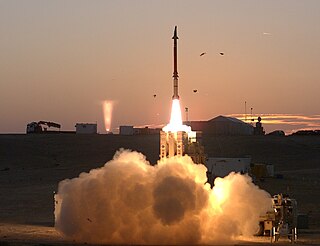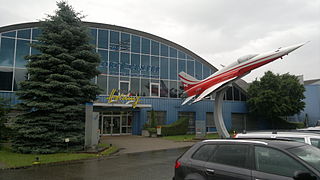
The NATO Integrated Air Defense System is a command and control network combining radars and other facilities spread throughout the NATO alliance's air defence forces. It formed in the mid-1950s and became operational in 1962 as NADGE. It has been constantly upgraded since its formation, notably with the integration of Airborne Early Warning aircraft in the 1970s. The United Kingdom maintained its own network, but was fully integrated with the network since the introduction of the Linesman/Mediator network in the 1970s. Similarly, the German network maintained an independent nature through GEADGE.

The MIM-104 Patriot is a surface-to-air missile (SAM) system, the primary such system used by the United States Army and several allied states. It is manufactured by the U.S. defense contractor Raytheon and derives its name from the radar component of the weapon system. The AN/MPQ-53 at the heart of the system is known as the "Phased Array Tracking Radar to Intercept on Target", which is a backronym for "Patriot". Starting in 1984, the Patriot system began to replace the Nike Hercules system as the U.S. Army's primary High to Medium Air Defense (HIMAD) system and the MIM-23 Hawk system as the U.S. Army's medium tactical air defense system. In addition to these roles, Patriot has been given a function in the U.S. Army's anti-ballistic missile (ABM) system. The system is expected to stay fielded until at least 2040.

An active electronically scanned array (AESA) is a type of phased array antenna, which is a computer-controlled array antenna in which the beam of radio waves can be electronically steered to point in different directions without moving the antenna. In the AESA, each antenna element is connected to a small solid-state transmit/receive module (TRM) under the control of a computer, which performs the functions of a transmitter and/or receiver for the antenna. This contrasts with a passive electronically scanned array (PESA), in which all the antenna elements are connected to a single transmitter and/or receiver through phase shifters under the control of the computer. AESA's main use is in radar, and these are known as active phased array radar (APAR).

The Swiss Air Force is the air component of the Swiss Armed Forces, established on 31 July 1914 as a part of the army and in October 1936 as an independent service.

The AN/MPQ-64 Sentinel is an X-band electronically steered pulse-Doppler 3D radar system used to alert and cue Short Range Air Defense (SHORAD) weapons to the locations of hostile targets approaching their front line forces. It is currently produced by Raytheon Missiles & Defense.

Secondary surveillance radar (SSR) is a radar system used in air traffic control (ATC), that unlike primary radar systems that measure the bearing and distance of targets using the detected reflections of radio signals, relies on targets equipped with a radar transponder, that reply to each interrogation signal by transmitting encoded data such as an identity code, the aircraft's altitude and further information depending on its chosen mode. SSR is based on the military identification friend or foe (IFF) technology originally developed during World War II, therefore the two systems are still compatible. Monopulse secondary surveillance radar (MSSR), Mode S, TCAS and ADS-B are similar modern methods of secondary surveillance.
Skyguide is an air navigation service provider which manages and monitors Swiss airspace. The company, which was formerly known as Swisscontrol, changed its name to skyguide in 2001. Skyguide is a joint-stock company under Swiss private law which is responsible, on behalf of the Swiss Confederation, for ensuring the safety of all Swiss airspace and of adjoining airspace areas in Germany, Austria, France and Italy that have been delegated to its control. For Swiss airspace, this duty extends to both civil and military air navigation services.

An airport surveillance radar (ASR) is a radar system used at airports to detect and display the presence and position of aircraft in the terminal area, the airspace around airports. It is the main air traffic control system for the airspace around airports. At large airports it typically controls traffic within a radius of 60 miles (96 km) of the airport below an elevation of 25,000 feet. The sophisticated systems at large airports consist of two different radar systems, the primary and secondary surveillance radar. The primary radar typically consists of a large rotating parabolic antenna dish that sweeps a vertical fan-shaped beam of microwaves around the airspace surrounding the airport. It detects the position and range of aircraft by microwaves reflected back to the antenna from the aircraft's surface. The secondary surveillance radar consists of a second rotating antenna, often mounted on the primary antenna, which interrogates the transponders of aircraft, which transmits a radio signal back containing the aircraft's identification, barometric altitude, and an emergency status code, which is displayed on the radar screen next to the return from the primary radar.

Hughes AN/TPQ-37 Firefinder Weapon Locating System is a mobile radar system developed in the late 1970s by Hughes Aircraft Company, achieving Initial Operational Capability in 1980 and full deployment in 1984. Currently manufactured by ThalesRaytheonSystems, the system is a long-range version of "weapon-locating radar", designed to detect and track incoming artillery and rocket fire to determine the point of origin for counter-battery fire. It is currently in service at brigade and higher levels in the United States Army and by other countries. The radar is trailer-mounted and towed by a 2+1⁄3-short-ton (2,100 kg) truck. A typical AN/TPQ-37 system consists of the Antenna-Transceiver Group, Command Shelter and 60 kW Generator.
Thales-Raytheon Systems Company LLC is an aerospace and defence company co-headquartered in Massy, Paris, France and Fullerton, California, United States. It is operated as a 50:50 joint venture between Raytheon Technologies and Thales Group.

David's Sling, also formerly known as Magic Wand, is an Israel Defense Forces military system being jointly developed by the Israeli defense contractor Rafael Advanced Defense Systems and the American defense contractor Raytheon, designed to intercept enemy planes, drones, tactical ballistic missiles, medium- to long-range rockets and cruise missiles, fired at ranges from 40 to 300 km. David's Sling is meant to replace the MIM-23 Hawk and MIM-104 Patriot in the Israeli arsenal.

The Ground Master 400 is a mobile radar system manufactured by Thales-Raytheon Systems, then Thales Group. GM400 is a fully digital active electronically scanned array long-range air defense 3D radar, offering detection from very high to very low altitudes. It tracks a wide range of targets from highly maneuverable tactical aircraft flying below several hundred feet to the unconventional small radar cross section devices, such as UAVs or cruise missiles.

TAFLIR is the abbreviation for the "Tactical Flight Radar" of the Swiss Air Force. TAFLIR is used to improve the Recognized Air Picture and to support air traffic control and air surveillance of the Swiss Air Force.

The Target allocation radar TPS-1E is an omnidirectional pulse radar device. It was used from 1958 until 1989 by the Swiss Air Force. It was also used by German army (Heer) air defence reconnaissance platoons up until the early 1990s.

The Federal Office for Defence Procurement (Armasuisse) is a federal agency of the Swiss Confederation. It is the procurement organization for armaments of Switzerland and is affiliated with the Federal Department of Defence, Civil Protection and Sport.

The Flieger Flab Museum is located in the Canton of Zurich in Dübendorf on the grounds of Dübendorf Air Base. In the museum, 40 airplanes and helicopters are displayed, with the collection divided into distinct eras: pioneers and World War I, the 1930s, World War II and the postwar period, the beginning of the jet age, the development of jet fighters, the Cold War, and arms reduction.

The LGR-1 was used by Swiss Air Force from 1948 until 1955 for positioning the planned radar air surveillance system. It is now in the Flieger-Flab-Museum at Dübendorf.

The SFR Airspace monitoring and management system was the first Airspace monitoring and management system of the Swiss Air Force.

The FLORIDA Airspace Monitoring And Management System was an airspace monitoring and management system of the Swiss Air Force. It was built by Hughes Aircraft Company. It is located in Fullerton, California.

The Fliegerstaffel 24 fighter squadron 24 of the Swiss Air Force was a former standalone squadron, which is now the ECM (German:EKF) part of the Zielflugstaffel 12. It is a militia squadron and belongs to the airfield command 7. Its home base is the Militärflugplatz Emmen. The Fliegerstaffel 24 carries as coat of arms an eagle in front of a light blue background, holding a lightning bolt in the right claw, in the background is a red-orange number 24 and above the coat of arms is a red-orange area with the black writing "Fliegerstaffel".






















